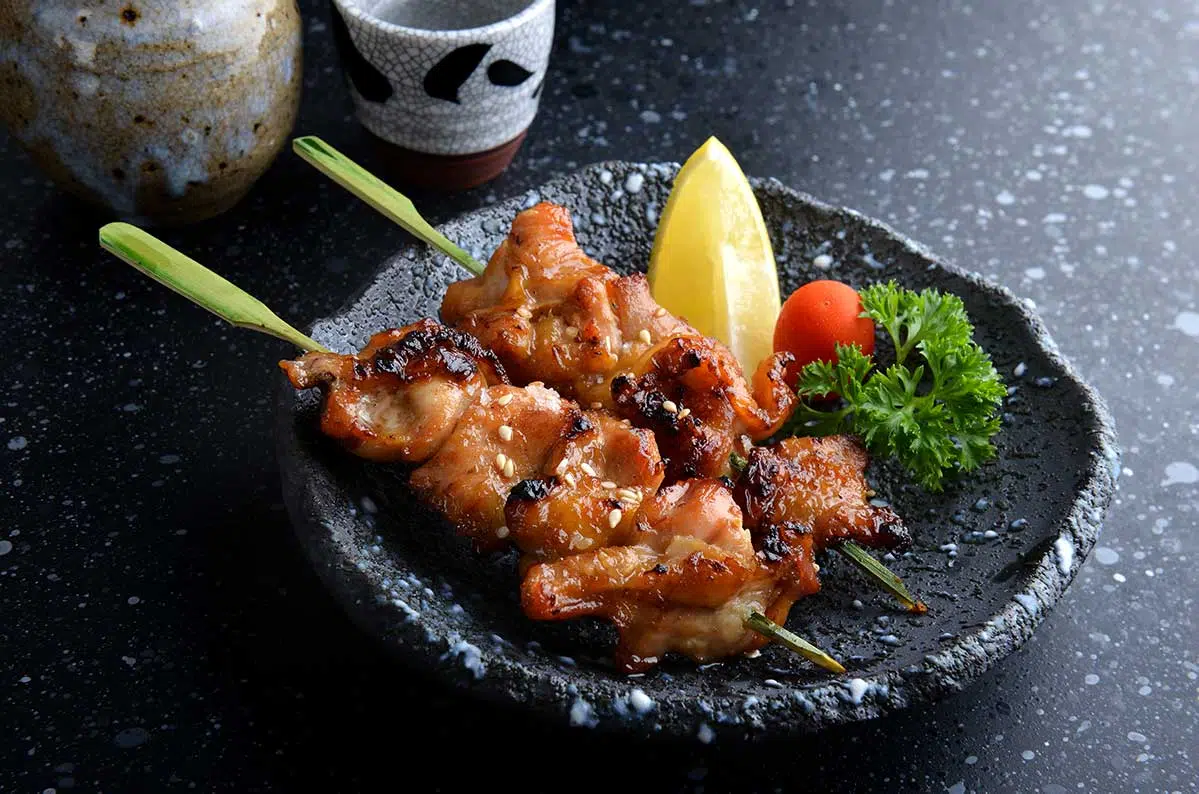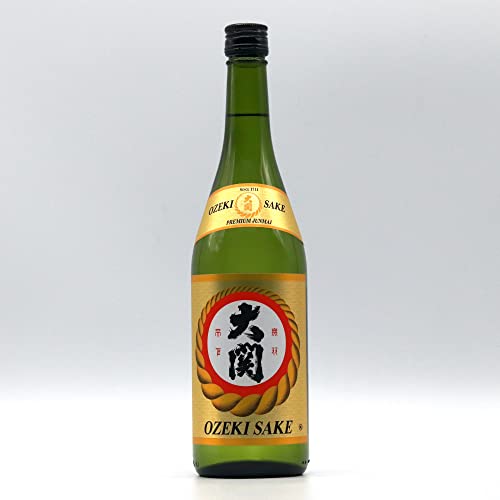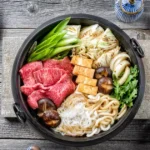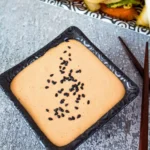Welcome to the world of mouthwatering Japanese cuisine! In this article, we will explore the tantalizing realm of Chicken Skewers Yakitori.
With its succulent pieces of grilled chicken, marinated in a rich soy-based sauce, Chicken Skewers Yakitori is a dish that embodies the perfect balance of flavours.
Whether you’re a seasoned food enthusiast or someone who enjoys trying new culinary experiences, Chicken Skewers Yakitori is a must-try delicacy that will leave you craving more.
So, grab your chopsticks and get ready to embark on a delicious journey as we delve into the art of preparing and savouring Chicken Skewers Yakitori.
1. What is Chicken Skewers Yakitori?

The Origins of Yakitori
Let’s start by unravelling the fascinating history of Yakitori. Yakitori is a traditional Japanese dish that traces its roots back to the Edo period. Originally sold as street food, Yakitori quickly gained popularity and became a staple in Japanese cuisine. The term “yakitori” translates to “grilled bird” and primarily refers to skewered and grilled chicken, although other meats and vegetables can also be used.
The Essence of Chicken Skewers Yakitori
Chicken Skewers Yakitori embodies the art of simplicity and attention to detail. It captures the essence of Japanese cooking, where the quality of ingredients takes centre stage. The dish consists of bite-sized pieces of chicken, typically thigh or breast meat, skewered on bamboo sticks and grilled over an open flame. The cooking process, combined with the unique flavours of the yakitori sauce, results in a delightful combination of smoky, savoury, and slightly sweet tastes.
The Key Ingredients for Authentic Yakitori
To create an authentic Chicken Skewers Yakitori, you’ll need a handful of essential ingredients. The star of the show is, of course, the chicken. It’s crucial to use high-quality chicken that is fresh and preferably free-range, as it enhances the flavour and tenderness of the meat. Additionally, the yakitori sauce, known as “tare,” is a vital component. It typically consists of soy sauce, mirin (a sweet rice wine), sake (Japanese rice wine), sugar, and sometimes ginger or garlic for added depth of flavour.
2. Preparing the Perfect Chicken Skewers
Choosing the Right Chicken Cuts
When it comes to Chicken Skewers Yakitori, choosing the right cuts of chicken is essential to achieve the perfect balance of flavours and textures. While both thigh and breast meat work well, many yakitori enthusiasts prefer thigh meat due to its higher fat content, resulting in a juicier and more tender skewer. Thigh meat is also more forgiving during the grilling process, reducing the risk of dry chicken.
Marinating the Chicken for Maximum Flavor
Marinating the chicken is a crucial step that infuses the meat with the delectable flavours of the yakitori sauce. To achieve maximum flavour, it’s recommended to marinate the chicken for at least 30 minutes, but overnight marination can yield even better results. The longer the marination, the more pronounced the flavours become. Ensure that each piece of chicken is coated evenly with the marinade, allowing the sauce to penetrate the meat.
Skewering Techniques and Presentation
Skewering the chicken requires attention to detail to ensure even cooking and an aesthetically pleasing presentation. Bamboo skewers are commonly used for yakitori, as they can withstand high heat and add a rustic touch to the dish. When skewering the chicken, be mindful of spacing the pieces evenly to promote consistent cooking. It’s also a good idea to leave a small gap between each piece to allow for better heat circulation.
3. Grilling Techniques: Mastering the Yakitori Grill
Traditional Charcoal Grilling
The traditional method of grilling Chicken Skewers Yakitori involves using charcoal, which imparts a smoky aroma and enhances the overall flavour profile of the dish. Charcoal grilling requires patience and attention to detail. Start by lighting the charcoal and allowing it to burn until it reaches a white-hot stage. Then, place the skewered chicken on the grill, ensuring that the heat is distributed evenly. Turn the skewers frequently to prevent uneven cooking and achieve those sought-after grill marks.
Gas Grilling for Convenience
If you don’t have access to a charcoal grill or prefer a more convenient option, gas grilling can also yield delicious results. Gas grills provide precise temperature control, making them ideal for beginners or those seeking a hassle-free grilling experience. Preheat the grill to medium-high heat and place the skewered chicken on the grates. Cook the chicken, turning occasionally, until it reaches an internal temperature of 165°F (74°C) and the surface develops a beautiful caramelized colour.
Tips for Achieving Perfect Grill Marks
Achieving those coveted grill marks on your Chicken Skewers Yakitori adds visual appeal and enhances the overall presentation. Here are some tips to help you achieve perfect grill marks:
- Preheat the grill properly to ensure optimal heat distribution.
- Oil the grates lightly to prevent sticking and promote those distinct charred lines.
- Rotate the skewers 45 degrees halfway through the cooking process to create crosshatch grill marks.
- Avoid overcrowding the grill to allow each skewer enough space for proper searing.
4. Yakitori Sauce: The Heart of the Dish
The Classic Tare Sauce
The yakitori sauce, known as “tare,” is the heart and soul of Chicken Skewers Yakitori. The classic tare sauce is a combination of soy sauce, mirin, sake, sugar, and sometimes additional ingredients like ginger or garlic. The precise measurements can vary, allowing for personal preferences and regional variations. The tare sauce is brushed onto the chicken during the grilling process, creating a glaze that caramelizes and intensifies the flavours.
Exploring Flavor Variations
While the classic tare sauce is a beloved staple, there are several flavorful variations you can explore to elevate your Chicken Skewers Yakitori experience. Here are a few popular options:
- Teriyaki Sauce: A sweeter alternative, teriyaki sauce combines soy sauce, mirin, sugar, and sometimes honey or fruit juices. It adds a luscious glaze and a touch of sweetness to the chicken.
- Yuzu Kosho Sauce: Yuzu kosho is a condiment made from yuzu zest, chilli peppers, and salt. It adds a tangy, citrusy kick to the yakitori, balancing the richness of the chicken.
- Miso Glaze: Incorporating miso paste into the tare sauce adds depth and umami to the yakitori. It pairs exceptionally well with chicken thigh skewers.
Homemade vs. Store-Bought Sauces
Making your own yakitori sauce from scratch allows for customization and experimentation with flavours. However, if you’re short on time or prefer convenience, there are excellent store-bought options available. Look for authentic Japanese brands or artisanal sauces that use high-quality ingredients for the best results. Ready-made sauces can be a time-saving option without compromising on taste.
5. Popular Yakitori Variations
Tsukune: The Irresistible Chicken Meatball Skewers
Tsukune is a mouthwatering variation of Chicken Skewers Yakitori that features juicy chicken meatballs. To prepare tsukune, ground chicken is combined with ingredients like breadcrumbs, egg, garlic, ginger, and green onions. The mixture is then shaped into small meatballs and skewered. Tsukune is grilled until golden brown and basted with tare sauce, resulting in succulent and flavorful skewers that are hard to resist.
Negima: A Combination of Chicken and Leek
Negima is a classic yakitori variation that combines chicken and leek, resulting in a delightful contrast of flavours. Thinly sliced chicken is alternated with pieces of leek on the skewers. The leek imparts a subtle sweetness and a slight crispness to the dish. When grilled to perfection, Negima offers a harmonious blend of savoury chicken and aromatic leek, making it a popular choice among yakitori enthusiasts.
Tebasaki: Savory Chicken Wing Skewers
Tebasaki is a yakitori variation that showcases the deliciousness of chicken wings. The wings are typically split into two parts, the drumette and the wingette, and skewered for grilling. Tebasaki is known for its robust and savoury flavours, achieved by marinating the chicken wings in a slightly different sauce than the classic tare. It’s a finger-licking treat that will satisfy any wing lover’s cravings.
6. Side Dishes and Accompaniments
Japanese Pickles (Tsukemono)
When indulging in Chicken Skewers Yakitori, don’t forget to complement the flavours with traditional Japanese pickles, known as tsukemono. Tsukemono is preserved vegetable that undergoes a fermentation or pickling process, resulting in a tangy and refreshing accompaniment. Common types of tsukemono include pickled cucumbers, radishes, cabbage, and eggplant. Their vibrant colours and varying textures add a delightful contrast to the yakitori experience.
Miso Soup: The Perfect Companion
Miso soup is a staple in Japanese cuisine and pairs harmoniously with Chicken Skewers Yakitori. Made from fermented soybean paste, miso soup offers a rich umami flavour that complements the smoky and savoury notes of the yakitori. It typically contains ingredients like tofu, seaweed, and green onions, adding depth and nutritional value to the meal. Sipping on a bowl of warm miso soup alongside your yakitori is the epitome of comfort and satisfaction.
Rice: The Staple Base
Rice, the staple of Japanese cuisine, serves as the perfect base for your Chicken Skewers Yakitori. Whether it’s steamed white rice or fragrant sushi rice, the simplicity and neutral flavour of rice allow the yakitori to shine. The fluffy grains of rice absorb the savoury juices from the yakitori, creating a delightful combination of textures and flavours. Consider adding some furikake (a Japanese seasoning blend) or sprinkling sesame seeds on your rice for added aroma and crunch.
7. Chicken Skewers Yakitori: FAQs
While chicken is the most common protein used in yakitori, the beauty of this dish lies in its versatility. You can experiment with various types of meat such as pork, beef, seafood, or even tofu to create unique flavour combinations. Each type of meat requires specific cooking times and techniques, so it’s essential to adjust accordingly to achieve the desired results.
Indeed! Vegetarian yakitori options are available for those who prefer plant-based alternatives. Instead of meat, you can use a variety of vegetables like mushrooms, bell peppers, zucchini, or cherry tomatoes. Marinate the vegetables in the tare sauce and grill them to perfection for a vegetarian-friendly yakitori experience.
Yes, you can still enjoy the deliciousness of Chicken Skewers Yakitori even without a grill. If you don’t have access to a grill, you can use a broiler in your oven or a stovetop grill pan. Simply adjust the cooking time and keep an eye on the skewers to prevent them from burning. The key is to achieve that caramelized exterior while keeping the meat tender and juicy.
The traditional yakitori sauce contains soy sauce, which is typically made from fermented soybeans and wheat. However, gluten-free tamari soy sauce is a suitable alternative for those with gluten sensitivities or allergies. Tamari soy sauce is made without wheat and offers a similar flavour profile. When preparing gluten-free Chicken Skewers Yakitori, make sure to use tamari soy sauce or gluten-free soy sauce options.
Yakitori is best enjoyed fresh off the grill, but you can prepare certain elements in advance to save time. You can marinate the chicken overnight to allow the flavours to develop. Additionally, you can skewer the chicken in advance and store it covered in the refrigerator until ready to grill. However, it’s recommended to brush the tare sauce on the chicken just before grilling to avoid any potential moisture loss.
While it’s possible to freeze Chicken Skewers Yakitori, it’s important to note that the texture may be slightly affected upon thawing and reheating. If you choose to freeze yakitori, ensure that it’s properly wrapped or stored in an airtight container to maintain its quality. When reheating, use gentle heat to prevent overcooking or drying out the chicken.
8. Chicken Skewers Yakitori: Conclusion
In conclusion, Chicken Skewers Yakitori offers a delightful culinary experience that showcases the simplicity and artistry of Japanese cuisine. From its humble beginnings as street food to its status as a global sensation, yakitori has captured the hearts and palates of food enthusiasts worldwide.
Whether you’re grilling yakitori for a casual lunch, a special occasion, or a gathering with friends, the process of preparing and enjoying this dish is a celebration of flavour and togetherness. The succulent chicken, tantalizing sauces, and smoky aromas create a symphony of tastes that transport you to the vibrant streets of Japan.
So, fire up the grill, gather your loved ones, and embark on a delicious journey with Chicken Skewers Yakitori. Whether you stick to the classic recipe or explore exciting variations, yakitori is sure to leave a lasting impression on your taste buds and create cherished culinary memories.





 Based on 1 Review(s)
Based on 1 Review(s)


